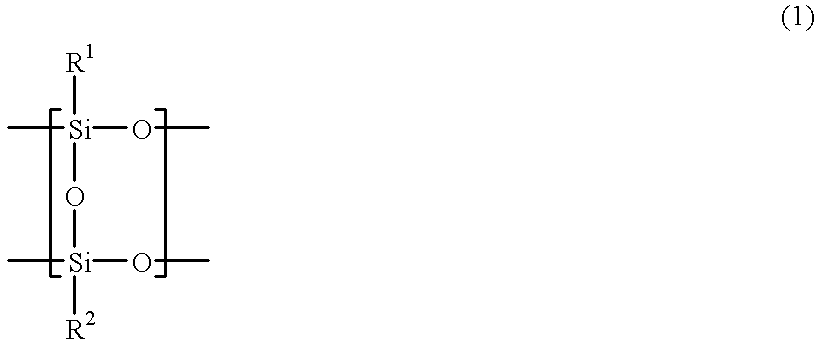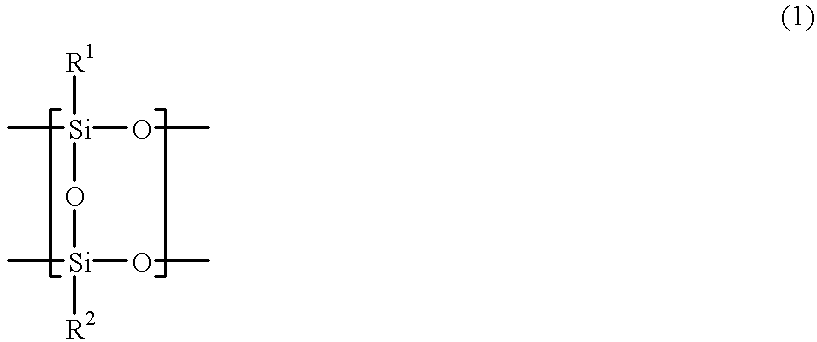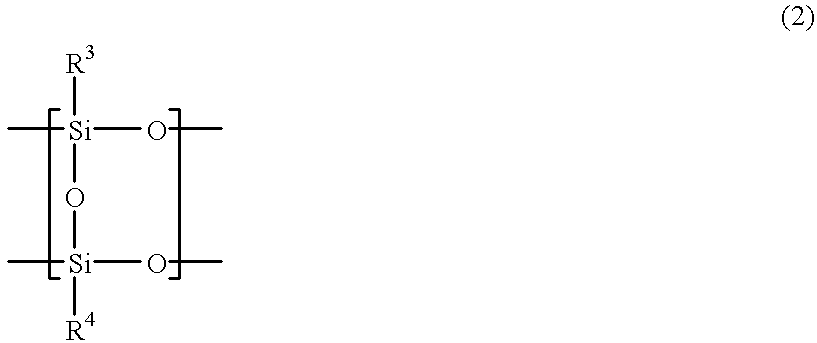Resist resin, resist resin composition and method of forming pattern using resist resin and resist resin composition
a technology of resist resin and composition, which is applied in the field of polysilsesquioxane-based chemical amplified type resist materials, can solve the problems of difficult compound to form a pattern with high sensitivity, difficult to enhance sensitivity, and difficult to form patterns with conventional monolayer resist processes. achieve excellent oxygen plasma etching resistance
- Summary
- Abstract
- Description
- Claims
- Application Information
AI Technical Summary
Benefits of technology
Problems solved by technology
Method used
Image
Examples
synthesis example 2
Synthesis of A-2: Polyorganosilsesquioxane (Terminal First-stage Capping) Having a Side Chain Group Ratio that Methyl to .gamma.-methacryloyloxypropyl is 11 to 1
19 g (0.1 mol) of .gamma.-methacryloyloxypropyltriethoxysilane, 196 g (1.1 mol) of methyltriethoxysilane and 50 g (2.8 mol) of water were put into a 500 ml flask having a thermometer, a stirrer and a reflux condenser. After 0.1 g of 1 mol / l nitric acid was added thereto, the resultant mixture was heated from a room temperature to allow an ethoxy group to be hydrolyzed so as to generate a hydroxyl group. Next, a condensation reaction was performed for two hours keeping a reaction temperature under a total reflux of about 82.degree. C. of azeotropic temperature of ethanol as a byproduct and water. Then, the condensation reaction was continued for more one hour while the azeotropic mixture of ethanol and water was being removed. The mixture was added with 32.5 g (0.2 mol) of hexamethylenedisiloxane and then reacted for two hour...
synthesis example 3
Synthesis of A-3: Polyorganosilsesquioxane (No Terminal Capping) Having a Side Chain Group Ratio that Methyl to .gamma.-methacryloyloxypropyl is 11 to 1
19 g(0.1 mol) of .gamma.-methacryloyloxypropyltriethoxysilane, 196 g (1.1 mol) of methyltriethoxysilane and 50.0 g (2.8 mol) of water were put into a 500 ml flask having a thermometer, a stirrer and a reflux condenser. After 0.1 g of 1 mol / l nitric acid was added thereto, the resultant mixture was heated from a room temperature to allow an ethoxy group to be hydrolyzed so as to generate a hydroxyl group.
Next, a condensation reaction was performed for six hours keeping a reaction temperature under a total reflux of about 82.degree. C. of azeotropic temperature of ethanol as a byproduct and water. Then, the condensation reaction was continued for three more hours while the azeotropic mixture of ethanol and water was being removed. The resultant reaction solution was cooled down to 35.degree. C., was taken out of a reaction system and k...
synthesis example 4
Synthesis of B-1: Acrylic Copolymer (Si Content Being 10 wt %) Having an A-1
6.9 g of the A-1 solution (a 50 wt % ethanol solution of polyorganosilsesquioxane (no terminal capping) having a side chain group ratio that methyl to .gamma.-methacryloyloxypropyl is 11 to 1) prepared in Synthesis Example 1, 10.16 g of tert-butyl methacrylate, 1.72 g of methacrylic acid and 93.9 g of propylene glycol monomethyl ether acetate (PGMEA) were first put into a 500 ml round bottom flask having a thermometer, a stirrer and a reflux condenser. Then 2 mol % each of azobisisobutyronitrile as a polymerization initiator and t-butyldodecanethiol as a chain transfer agent against 100 mol % of the monomer was added thereto. The resultant mixture was stirred for one hour under an atmosphere of nitrogen flow, then kept at 80.degree. C. as a reaction temperature for three hours and thereafter at 90.degree. C. for one hour to achieve an addition reaction.
Thereafter, the resultant reaction solution was poured i...
PUM
| Property | Measurement | Unit |
|---|---|---|
| mol % | aaaaa | aaaaa |
| mol % | aaaaa | aaaaa |
| mol % | aaaaa | aaaaa |
Abstract
Description
Claims
Application Information
 Login to View More
Login to View More - R&D
- Intellectual Property
- Life Sciences
- Materials
- Tech Scout
- Unparalleled Data Quality
- Higher Quality Content
- 60% Fewer Hallucinations
Browse by: Latest US Patents, China's latest patents, Technical Efficacy Thesaurus, Application Domain, Technology Topic, Popular Technical Reports.
© 2025 PatSnap. All rights reserved.Legal|Privacy policy|Modern Slavery Act Transparency Statement|Sitemap|About US| Contact US: help@patsnap.com



